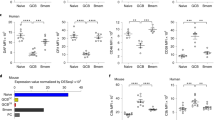Abstract
Three restriction points control the cell cycle of activated B lymphocytes1. The first occurs directly after mitosis and is controlled by the occupancy of surface-bound immunoglobulin. The second is observed ∼4 h after mitosis in the G1 phase of the cycle, that is, before DNA replication, and is controlled by growth factors that are produced by macrophages2 which we have previously classified as α-type factors3,4. The third restriction point occurs in the G2 phase, 2–4 h before mitosis, and is controlled by β-type growth factors probably produced by helper T lymphocytes5. The third component of complement, C3, has long been implicated in the control of B-cell responses6–12. C3 is secreted by monocytes and macrophages13,14. We have found recently that crosslinked, but not soluble, human C3 stimulates activated, but not resting, murine B cells to thymidine uptake15. Here we investigate the role of C3b and C3d in the progression of the cell cycle of activated, synchronized murine B cells. We find that crosslinked C3d replaces the action of α-factors within the cell cycle of these cells and allows entry into S phase. In contrast, soluble C3d inhibits the action of α-factors. This implies that a C3d-specific receptor, probably the murine analogue to the human complement receptor CR2 (refs 16, 17), is a growth factor receptor on activated B cells that will give the cell a growth-positive signal when it is crosslinked, while occupancy by the soluble form of C3d will result in inhibition of the action of α-factors or of crosslinked C3b or C3d. A stretch of weak homology between the cDNA sequence of murine C3d and those of murine growth factors indicates that an insulin-like growth factor could be the active principle of C3d that controls the cell cycle of activated B cells.
This is a preview of subscription content, access via your institution
Access options
Subscribe to this journal
Receive 51 print issues and online access
$199.00 per year
only $3.90 per issue
Buy this article
- Purchase on Springer Link
- Instant access to full article PDF
Prices may be subject to local taxes which are calculated during checkout
Similar content being viewed by others
References
Melchers, F., Corbel, C., Leptin, M. & Lernhardt, W. J. Cell Sci. (in the press).
Hoffmann, M. K., Hämmerling, U., Simon, M. & Oettgen, H. F. J. Immun. 116, 1447–1451 (1976).
Corbel, C. & Melchers, F. Immun. Rev. 78, 51–74 (1984).
Corbel, C. & Melchers, F. Eur. J. Immun. 13, 528–533 (1983).
Andersson, J. & Melchers, F. Cell 37, 715–720 (1984).
Pepys, M. B. Nature new Biol. 237, 157–159 (1972).
Dukor, P. & Hartmann, K.-U. Cell. Immun. 7, 359–356 (1973).
Hartmann, K.-U. & Bokisch, V. A. J. exp. Med. 142, 600–610 (1975).
Bitter-Suermann, D. et al. J. Immun. 111, 301 (1973).
Dukor, P. et al. J. exp. Med. 139, 337–354 (1974).
Pepys, M. B. J. exp. Med. 140, 126–144 (1974).
Klaus, G. G. B. & Humphrey, J. H. Immunology 33, 31–40 (1977).
Lai, A., Fat, R. F. M. & Van Furth, R. Immunology 28, 359–368 (1975).
Whaley, K. J. J. exp. Med. 151, 501–516 (1980).
Erdei, A., Melchers, F., Schulz, T. & Dierich, M. Eur. J. Immun. 15, 184–188 (1985).
Ross, G. D. Fedn Proc. 41, 3089–3093 (1982).
Fearon, D. T. Immun. Today 5, 105–110 (1984).
Miller, R. G. & Phillips, R. A. J. cell Physiol. 73, 191–202 (1969).
Andersson, J., Sjöberg, O. & Möller, G. Transplantn Rev. 4, 131–177 (1972).
Andersson, J., Coutinho, A. & Melchers, F. J. exp. Med. 149, 553–564 (1979).
Lindgren, A. & Westermark, B. Expl Cell Res. 99, 357–362 (1976).
Lindgren, A., Westermark, B. & Pontén, J. Expl Cell Res. 95, 311–319 (1975).
Stiles, C. D. et al. Proc. natn. Acad. Sci. U.S.A. 76, 1279–1283 (1979).
Leof, E. B., Wharton, W., van Wyk, J. J. & Pledger, W. J. Expl Cell. Res. 141, 107–115 (1982).
Wharton, W., van Wyk, J. J. & Pledger, W. J. J. cell. Physiol. 107, 31–39 (1981).
Wetsel, R. A. et al. J. biol. Sci. 259, 13857–13862 (1984).
GenBank, genetic bank sequence, locus MUSNGF, Release 26.0 (1984).
Bell, G. I. et al. Nature 310, 775–777 (1984).
Gray, A., Dull, T. J. & Ullrich, A. Nature 303, 722–725 (1983).
Scott, J. et al. Science 221, 236–240 (1983).
Jelinek, W. R. & Schmid, C. W. A. Rev. Biochem. 51, 813–844 (1982).
Ullu, E. & Tschudi, Ch. Nature 312, 171–172 (1984).
Gen Bank, genetic bank sequence, locus NUMHBE Release 26.0 (1984).
Gen Bank, genetic bank sequence, locus HUMALU7, Release 26.0 (1984).
Van Beveren, C. et al. Nature 289, 258–262 (1981).
Van Beveren, C., van Straaten, F., Galleshaw, J. A. & Verma, I. M. Cell 27, 97–108 (1981).
Doolittle, R. F., Feng, D. F. & Johnson, M. S. Nature 307, 558–560 (1984).
Ullrich, A. et al. Nature 309, 418–425 (1984).
Ullrich, A. et al. Nature 313, 756–761 (1985).
Iscove, N. N. & Melchers, F. J. exp. Med. 147, 923–933 (1978).
Hammer, C. H., Wirtz, G. H., Reufer, L., Gresham, H. D. & Tack, B. F. J. boil. Chem. 256, 3995–4003 (1981).
Author information
Authors and Affiliations
Rights and permissions
About this article
Cite this article
Melchers, F., Erdei, A., Schulz, T. et al. Growth control of activated, synchronized murine B cells by the C3d fragment of human complement. Nature 317, 264–267 (1985). https://doi.org/10.1038/317264a0
Received:
Accepted:
Issue Date:
DOI: https://doi.org/10.1038/317264a0
This article is cited by
-
Role of complement and Fc receptors in the pathogenesis of HIV-1 infection
Springer Seminars in Immunopathology (1997)
-
Impairment of T-cell-dependent B-cell responses and B-l cell development in CD19-deficient mice
Nature (1995)
-
CD21 is a ligand for CD23 and regulates IgE production
Nature (1992)
Comments
By submitting a comment you agree to abide by our Terms and Community Guidelines. If you find something abusive or that does not comply with our terms or guidelines please flag it as inappropriate.



